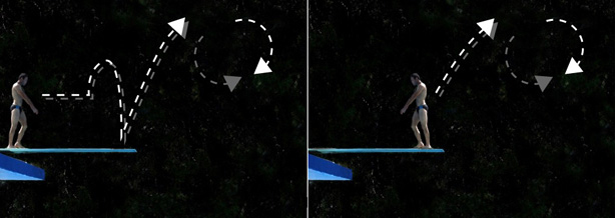Olympic Physics: Diving

Editor’s Note: The summer Olympics draw viewers to sports that they otherwise ignore. We marvel as athletes ranging from divers to pole vaulters turn power and speed into athletic artistry. Speed (velocity) and power (force) are also key elements in physics. This is the second in a series of guest posts by Dr. Larry Silverberg, an NC State professor of mechanical and aerospace engineering, who works in the area of engineering dynamics. He talked to NC State coaches Tom Wood (track and field), Jon Choboy (tennis), and Josh Karshen (diving) about the dynamics involved in their sports. You can follow all of our Olympic posts here, as we post them.
We call it the high dive but the athletes call it the three-meter springboard. The goal: to score the most points – earned by performing twists and flips ending with a splashless “rip” into the water.
Athletes in the three-meter springboard perform five different dives. Each is scored on the number of twists and flips, and on how the diver enters the water. If done right, the diver enters the water with virtually no splash – the only thing we hear sounds like ripping a piece of paper.
The five different dives are:
- The forward (front): The diver walks the board and jumps twice. Then the diver performs a tuck (pulls into a ball), a pike (keeps knees straight, legs outstretched), or a straight (whole body straight).Each is worth a different number of points. For example, a 3.5 pike is worth more than a 3.5 tuck. In each case, the body rotates forward (clockwise) three and a half times before the diver enters the water.
- The back: The diver starts from a standing position facing away from the pool. The diver then jumps backward, away from the board, spins backward and enters the water with their face and chest facing away from the board.
- The reverse: The diver walks the board and jumps twice. Then the diver performs a tuck, pike or a straight. But, unlike the forward, the diver rotates backward (counter-clockwise).
- The inward: The diver starts from a standing position facing away from the pool. The diver then jumps backwards – but rotates forwards.
- The twister: The dive can be forward or backward, but entails performing twisting somersaults in mid-air. The more twists and somersaults in the dive, the harder it is.
The reverse and the inward are a little more dangerous than the forward and the back, because the diver can hit his or her head on the diving board.
When walking the board, the diver performs his or her first jump about 12 to 16 inches from the end of the diving board. This is the sweet spot of the board. The jump produces the greatest elevation – transferring the most energy from the board to the diver. The second jump is performed with greater effort, giving him or her even more energy – to produce as high a jump as possible. Ultimately, this gives the diver more time in the air to perform the twists and flips.
In the second jump, body alignment and center of gravity (CG) are critical. The CG needs to be slightly behind the direction of the impact force on the feet in order for the force to produce translational motion, rather than rotational motion. Translational motion pushes the diver up, giving him or her greater height on the jump. Rotational motion would force the diver slightly forward or backward, rather than straight up.
Flying through the air, the diver now bends his body as much as possible to lower his mass moment of inertia (it’s like rotational mass) as much as possible in order to increase his rate of spin and therefore the number of revolutions. This is the most difficult stage. The diver also uses visual spotting of the water as feedback.
The last stage is called the entry. The diver wants to enter the water perfectly. To do that the diver enters the water hands-first, then rotates his arms from in front of his head to his waist as his body enters the water – clearing the water during the beginning of water entry and closing the wake produced by the body at the end of the water entry – producing almost no splash throughout the entire entry. It is important for the diver’s body to be as perpendicular as possible to the water when entering, because this presents the smallest possible surface to the water – minimizing the splash.
In the high dive, the United States has a promising Olympic team. Most of the U.S. squad was inexperienced four years ago and they are coming back as veterans. Diving events begin July 29. (Here’s more information on diving in the Olympics.) At NC State, a new diving coach is on the scene and is emphasizing fundamentals – the keys to success!
- Categories:


